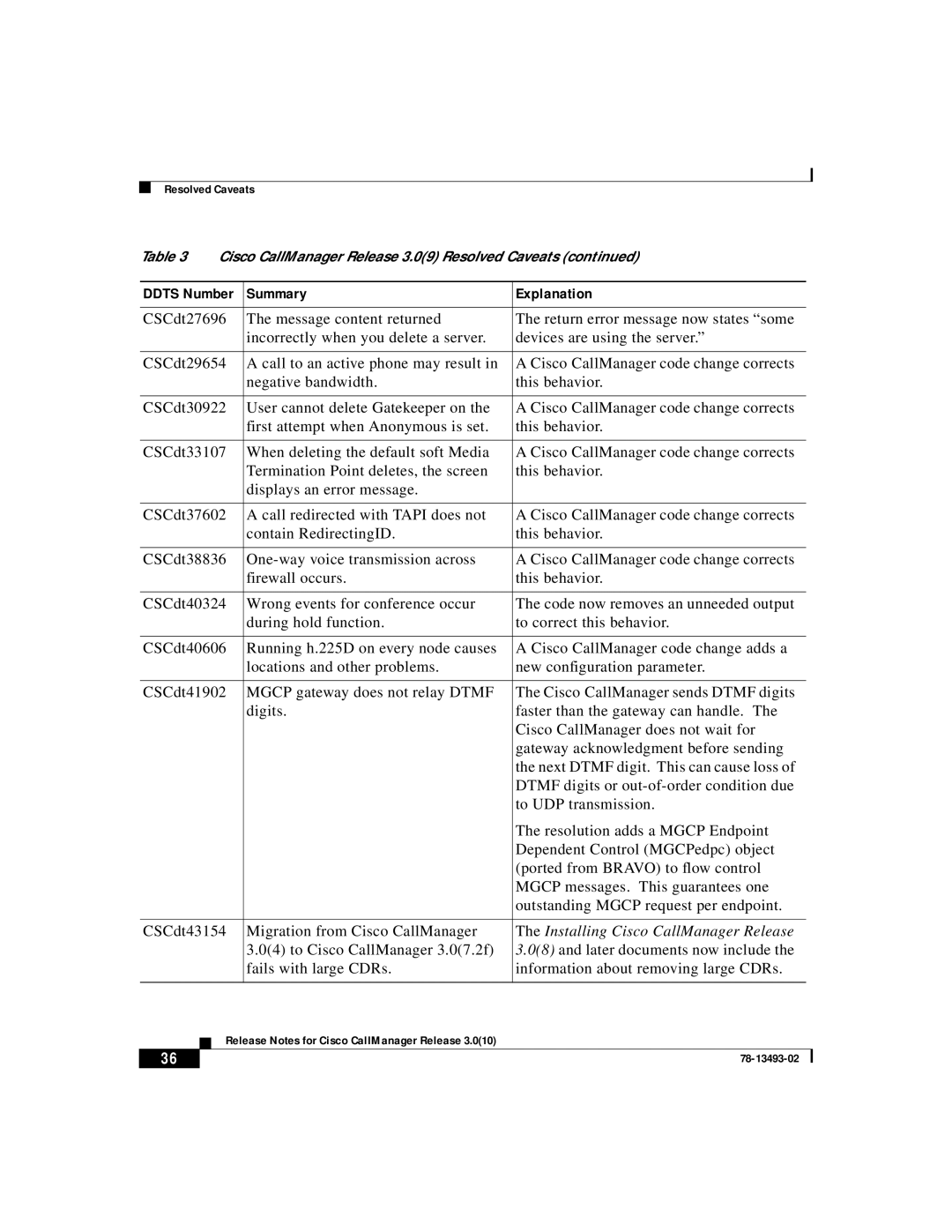
Resolved Caveats
Table 3 |
| Cisco CallManager Release 3.0(9) Resolved Caveats (continued) | ||||
|
|
|
| |||
DDTS Number | Summary | Explanation | ||||
|
|
|
| |||
CSCdt27696 | The message content returned | The return error message now states “some | ||||
|
|
| incorrectly when you delete a server. | devices are using the server.” | ||
|
|
|
| |||
CSCdt29654 | A call to an active phone may result in | A Cisco CallManager code change corrects | ||||
|
|
| negative bandwidth. | this behavior. | ||
|
|
|
| |||
CSCdt30922 | User cannot delete Gatekeeper on the | A Cisco CallManager code change corrects | ||||
|
|
| first attempt when Anonymous is set. | this behavior. | ||
|
|
|
| |||
CSCdt33107 | When deleting the default soft Media | A Cisco CallManager code change corrects | ||||
|
|
| Termination Point deletes, the screen | this behavior. | ||
|
|
| displays an error message. |
|
|
|
|
|
|
| |||
CSCdt37602 | A call redirected with TAPI does not | A Cisco CallManager code change corrects | ||||
|
|
| contain RedirectingID. | this behavior. | ||
|
|
|
| |||
CSCdt38836 | A Cisco CallManager code change corrects | |||||
|
|
| firewall occurs. | this behavior. | ||
|
|
|
| |||
CSCdt40324 | Wrong events for conference occur | The code now removes an unneeded output | ||||
|
|
| during hold function. | to correct this behavior. | ||
|
|
|
| |||
CSCdt40606 | Running h.225D on every node causes | A Cisco CallManager code change adds a | ||||
|
|
| locations and other problems. | new configuration parameter. | ||
|
|
|
| |||
CSCdt41902 | MGCP gateway does not relay DTMF | The Cisco CallManager sends DTMF digits | ||||
|
|
| digits. | faster than the gateway can handle. The | ||
|
|
|
| Cisco CallManager does not wait for | ||
|
|
|
| gateway acknowledgment before sending | ||
|
|
|
| the next DTMF digit. This can cause loss of | ||
|
|
|
| DTMF digits or | ||
|
|
|
| to UDP transmission. | ||
|
|
|
| The resolution adds a MGCP Endpoint | ||
|
|
|
| Dependent Control (MGCPedpc) object | ||
|
|
|
| (ported from BRAVO) to flow control | ||
|
|
|
| MGCP messages. This guarantees one | ||
|
|
|
| outstanding MGCP request per endpoint. | ||
|
|
|
| |||
CSCdt43154 | Migration from Cisco CallManager | The Installing Cisco CallManager Release | ||||
|
|
| 3.0(4) to Cisco CallManager 3.0(7.2f) | 3.0(8) and later documents now include the | ||
|
|
| fails with large CDRs. | information about removing large CDRs. | ||
|
|
|
|
|
|
|
|
| Release Notes for Cisco CallManager Release 3.0(10) |
|
|
| |
|
|
|
|
| ||
36 |
|
|
|
|
| |
|
|
|
| |||
